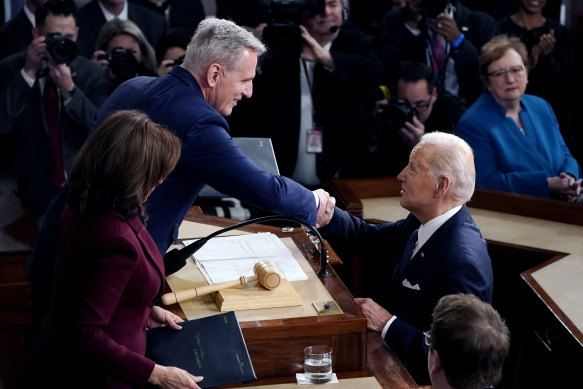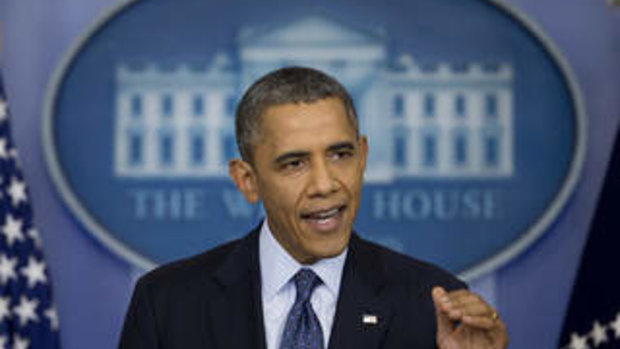Five things to know about the US debt ceiling

Save articles for later
Add articles to your saved list and come back to them any time.
Washington: US President Joe Biden has met with the top Republicans and Democrats in Congress to try to resolve a months-long stand-off over the government’s debt ceiling that has brought the nation close to the brink of default and economic crisis.
President Joe Biden arrives and shakes hands with House Speaker Kevin McCarthy during his State of the Union speech in February. Today, the two are at loggerheads over the debt ceiling.Credit: AP
What is the debt ceiling?
Washington regularly sets a limit on federal borrowing. Currently, the ceiling is set at $US31.4 trillion ($47.1 trillion), equal to roughly 120 per cent of the country’s annual economic output. The debt reached that ceiling in January and the Treasury Department has kept obligations just within the limit by suspending investments in some federal pension funds while continuing to borrow from investors.
The Treasury warned last week that it could have to stop borrowing altogether and rely solely on tax receipts to pay its bills by as soon as June 1, though it also said that cut-off, known as the “X-date” could occur several weeks later.
Because the Treasury borrows close to 20 cents for every dollar it spends, Washington at that point would start missing payments owed to lenders, citizens or both.
Is the debt ceiling good for anything?
Few counties in the world have debt ceiling laws and Washington’s periodic lifting of the borrowing limit merely allows it to pay for spending Congress has already authorised.
Treasury Secretary Janet Yellen and other policy experts have called on Washington to eliminate the limit because it amounts to a bureaucratic stamp on decisions already made.
Some analysts have proposed that the Treasury can bypass the crisis by minting a multitrillion-dollar platinum coin and putting it in the government’s account, an idea widely seen as an outlandish gimmick. Others argue the debt ceiling itself violates the US Constitution.
What happens when Washington can no longer borrow money?
Shockwaves would ripple through global financial markets as investors question the value of US bonds, which are seen as among the safest investments and serve as building blocks for the world’s financial system.
In 2011, for example, the battle over a debt increase spooked global markets. The uncertainty sent sharemarkets plunging, and prompted credit rating agency Standard & Poor’s, in a first, to downgrade the country’s borrower rating from A+.
The US economy would almost certainly fall into a recession if the government was forced to miss payments on things like soldiers’ salaries or Social Security benefits for the elderly. Economists expect that millions of Americans would lose their jobs. Already, investors have shunned some US debt securities that come due in July and August as they try to avoid bills maturing when the risk of a debt default is highest.
How did we get here?
Republicans, who hold a narrow 222-213 majority in the House of Representatives, in late April passed a bill that would raise the debt limit in return for sweeping spending cuts over the next decade.
The bill has no chance of approval in the Democratic-controlled US Senate. House Speaker Kevin McCarthy wants Biden to negotiate on spending cuts even as the White House insists on a debt limit increase with no strings attached. Hence, the standstill.
Biden’s full $US6.8 trillion fiscal 2024 budget proposal doubles down on his economic agenda to shrink inequality, with funds for pre-schooling, childcare and more healthcare. It is to be funded by with tax increases on wealthy Americans and corporations.
McCarthy and his fellow Republicans’ “Limit Save and Grow Act” is a spending reduction bill that would cut 2024 federal discretionary spending to 2022 levels and rescind Biden’s signature programs already approved by Congress.
Full enactment of the Republican bill, Republicans argue, would result in total 10-year deficit reduction of $US4.804 trillion from a February baseline.
Full enactment of the fiscal 2024 budget request would reduce deficits by $US2.857 trillion, according to the White House.
Then president Barack Obama tells a news conference in the White House in July 2011 that the US economy risked a “very deep recession” if Congress didn’t raise the then $US16.7 trillion debt ceiling.Credit: Bloomberg
Haven’t we heard this song before?
This kind of brinkmanship has been part of US politics for decades but worsened significantly after fiscal hawks in the Republican Party grew in power since 2010.
In a 2011 showdown, House Republicans successfully used the debt ceiling to extract sharp limits on discretionary spending from Democratic president Barack Obama.
Spending caps stayed in place for most of the rest of the decade, but the episode rattled investors and led to a historic downgrade of the US credit rating.
Reuters
Most Viewed in World
From our partners
Source: Read Full Article


